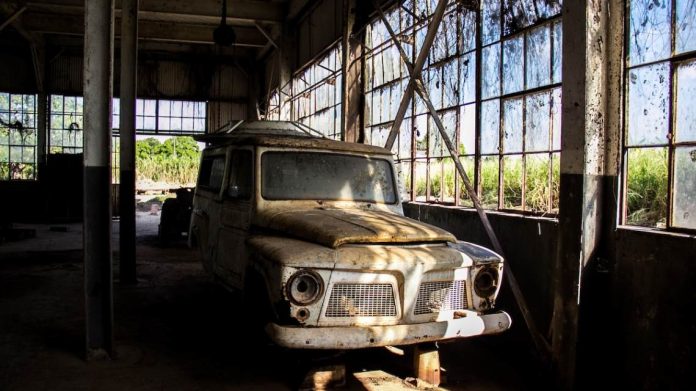Once upon a time, deep in the heart of the Amazon Rainforest, a transplanted slice of the American dream sprung to life. This is the almost forgotten story of Fordlandia.
Journey to the heart of the Amazon
It was the late 1920s, and automotive giant Henry Ford was looking for a dependable, affordable source of rubber — suddenly a precious material for the booming automobile industry.
With the British completely controlling the rubber production coming out of Asia, Ford started to look abroad for his own supply. He eventually landed his eyes on a remote area of Brazil’s Amazon Rainforest.

Portrait of Henry Ford (1919). Credit: Wikimedia Commons.
A full day’s journey by boat from the nearest city, the Amazon was still the wild, untamed frontier. It was exactly there that an American industrial dream began to take root. Fordlandia, as it would eventually be called, was a huge gamble, but Ford was up for the challenge.
Jungle all the way: A rubber kingdom rises
Ford’s ambition was as vast as the land he acquired in 1928. He didn’t just purchased 2.5 million acres of land from the Brazilian government, but he also set out to build an entirely self-sufficient plantation where the workers would live, a sort of prototypical American community with picket fences, Cape Cod-style houses, and streets lined up with light posts and bright red fire hydrants.
Fordlandia, as Ford envisioned it, would have swimming pools, a tennis court, and a golf course, but also no alcohol and a strict diet of “brown rice and whole-wheat bread and canned peaches and oatmeal.” There were even mandatory weekend activities such as square-dancing and poetry readings.
The American dream meets Amazon reality
Ford’s American dream didn’t mesh well with Amazon’s reality and the project experienced problems right from the start. The native workers, not used to a regimented, factory-style routine, soon started to rebel.
The first complaint was the food, far removed from the traditional Brazilian fare, as well as the cafeteria-style servings that didn’t match the local way of eating around the dinner table. The prohibition of sale and consumption of alcohol was another point of contention. This issue was soon solved by the rise of tiny villages nearby (dubbed the “Island of Innocence”) offering plenty of cachaça—a popular local spirit.
Workers soon dubbed Fordlandia the “Inferno verde” or “Green Hell” because the combination of bad food, malaria from poor mosquito management (a big complaint was that beds didn’t have mosquito nets), and deadly snakes meant that many of the residents were constantly sick.
Riots, rumbles and a resounding retreat: The swan song of Ford’s dream
Then there was the issue of the rubber trees themselves. Although rubber trees are native to the Amazon, in the wild they grow sporadically and over large spaces. A very different setup to the highly packed, orderly rows of trees that Ford’s agricultural engineers used. This unnatural planting provided an easy pathway for tree blight and pests to spread. This not only led to flies invading Fordlandia but also devastated the trees.
By 1930, worker discontent had grown into outright rebellion. Workers rioted, destroying property and forcing the Brazilian military to step in to quell the uprising. It was becoming apparent that Fordlandia was not going to be the rubber-producing utopia that Ford had imagined.
For the next few years, Ford tried everything, including bringing a botanist to figure out why the trees weren’t thriving. Turned out the damp, hilly terrain was the perfect environment for the blight to prosper, but not at all the right place for the trees themselves because of poor soil quality.
Undeterred, Ford bought more land with better soil nearby and started again from scratch. By 1942, even the newest branch of his enterprise was producing a mere 750 tons of latex a year — nowhere near the 38,000 tons needed for the investment to be worth it. In the end, “not one drop of latex from Fordlandia ever made it into a Ford car.“
Fordlandia today: A dream remembered
Disaster after disaster struck Fordlandia. A caterpillar and fungus plague, followed by the invention of synthetic rubber, which made rubber trees irrelevant. In 1945, Ford abandoned his dream and sold the land back to the Brazilian government — he had lost over $20 million building his dream, a place he never even had a chance to visit.

Abandoned building with broken windows and the historic water tank tower of Fordlandia.
Today, Fordlandia stands as a relic of the past. The American-style houses, hotel, and water tower have been taken over by nature and bats and other wildlife now inhabit the ruins. While looters eventually stole any equipment left behind, enough buildings were left standing than by the year 2000, people started moving back in.
About 2,000 people live in the former Fordlandia today, a mix of farm workers and poverty-stricken migrants from other parts in Brazil. They survive by growing their own food and supplement their income with government pensions or social welfare payments. Many moved into the American-style bungalows left behind when Fordlandia managers packed up and left.
Fordlandia may not have turned out as Henry Ford planned, but it remains a fascinating example of chasing your dreams, wherever they take you.
By Diana Bocco, contributor for Ripleys.com
EXPLORE THE ODD IN PERSON!
Hits: 0












